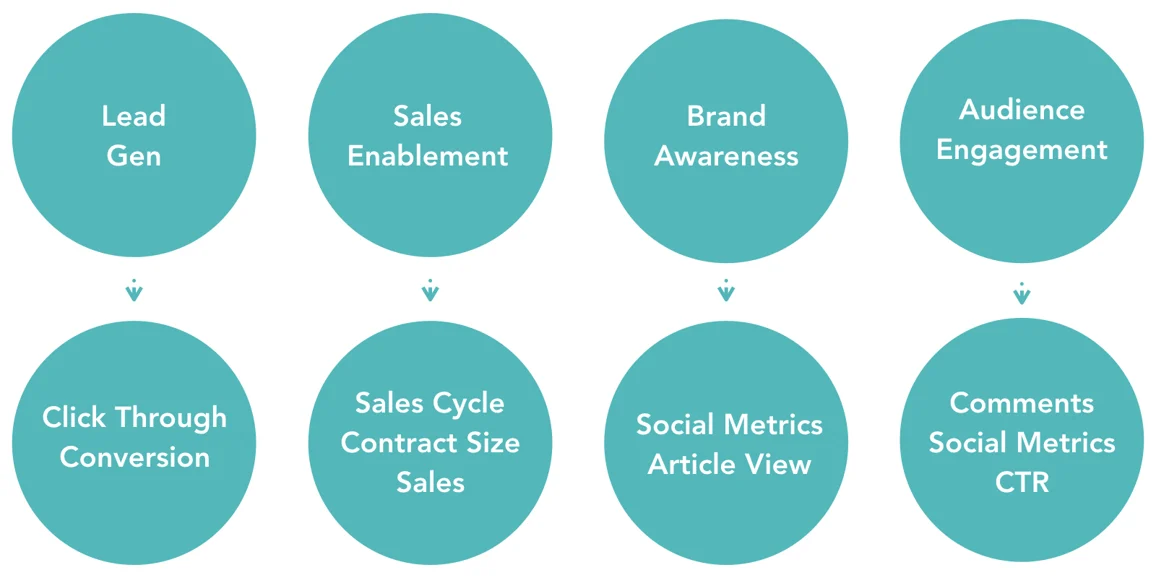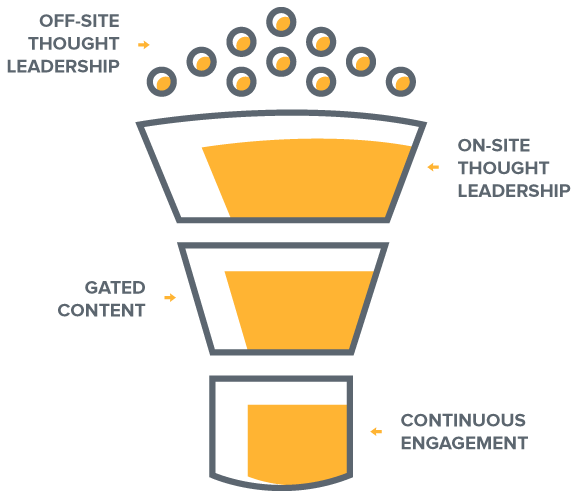
What Is Content Marketing? Your Ultimate Guide
What Is Content Marketing? Your Ultimate Guide
Kelsey Raymond, COO • Intero Digital • September 12, 2017
Consistent, high-quality content is one of the most effective tools you have to reach your company’s goals. From brand building and lead generation to sales enablement, client and partner nurturing, recruitment, and more, content marketing can help.
Before you jump into pumping out dozens of pieces of content as fast as you can, take a second look at what makes this content so effective: It’s high-quality and consistent.
Although the vast majority of B2B marketers report using some sort of content marketing, many teams fail to generate the results they desire. Part of that disillusionment comes from the belief that “doing content marketing” starts and stops at having a blog.
Content marketing is a comprehensive strategy. It includes a stellar blog, for sure, but it also needs guest posting, PR, distribution, SEO, and in-depth analytics to help you make the most of your investment.
Our industry research report, “The State of Digital Media,” uncovered key findings that could directly affect your efforts.
- Content is frequently published midweek. The majority of content is published during the week, with a spike on Tuesday that increases into Wednesday and dips slightly into Thursday before settling.
- Editors want your content. Ninety-six percent of online publication editors report they’re planning to publish the same amount or more of contributed content.
- Your unique expertise matters. Eighty-five percent of editors say the reason they accept and publish guest content is to share new insights with their readers.
- Social shares lead to success. Sixty-six percent of editors say they measure the success of guest posts by the number of social shares they receive.
- Hit the word count sweet spot. Content with 1,000 shares or more has an average word count of 590 to 790 words.
To truly take your content marketing to the next level and generate leads, nurture and close sales, and build your brand, your content must be high-quality, strategic, and valuable to your audience — and it can’t stop after a few published blog posts.
In this guide, we will walk you through the necessary steps to get your content marketing strategy into top-notch condition and achieve the results you’re after. Through these six steps, you’ll learn how to transform your company’s content marketing from mediocre blogging to full-fledged brand publishing and skyrocket your ROI.
6 Ways to Take Your Content Marketing to the Next Level
1. Go beyond just blogging.
We hate to call you out, but if you’re simply using your blog to post company updates, brief thoughts, or snippets of industry news, then you aren’t taking full advantage of its potential, and you certainly aren’t doing content marketing.
Think of your company blog as a home base for your content strategy. It’s a central hub for your content, a place to test your efforts and process, and it’s completely under your control. So it’s imperative to maximize your efforts where it counts: on your blog.
While sharing company updates might be helpful for you and your employees internally, your blog can speak to a broader audience, and hyperspecific news really isn’t all that helpful to your readers’ efforts to solve their problems. To truly attract and engage your target audience, your blog has to be entertaining, address questions and pain points, and serve as an educational resource for your readers.
What a Successful Company Blog Looks Like
- It’s a valuable resource. Your blog content shares key insights and takeaways that are specific to your industry — that means tips, tricks, and how-tos your readers can actually apply to their business practices.
- It’s goal-oriented. Each piece of content has a specific purpose behind it. Whether that purpose is to boost audience engagement, generate leads, or enable sales, having a clear goal in mind helps you stay on track and serve your audience best.
- It links to other content. Part of successful blogging is enticing readers to hang out on your site for a bit; you don’t want them to land on a page and leave right away. Your blog achieves this by linking to other valuable, relevant content to expand on points within articles.
- It includes a relevant CTA. Calls to action in your post direct readers to submit their contact information in exchange for a piece of gated content. That content varies and can include things like guides, e-books, whitepapers, reports, and other freebies — as long as it’s relevant to the blog post and valuable to the reader.
- It maintains variety. Your blog spices things up with images, infographics, or unique topics that might be outside the norm to keep your readers engaged on all fronts.
- It’s consistent. However frequently you decide you need to publish to reach your goals, you need to create a schedule and stick to it. This takes commitment, but it’s one of the best ways to build a loyal audience and make your content strategy worthwhile.
- It’s effectively distributed. You distribute your content strategically through multiple channels, such as a weekly newsletter, social media, and client or influencer shares, to make sure that it gets in front of the right audience at the right time. After all, your content doesn’t do you any good if no one ever sees it.
Getting the most value out of your efforts typically takes more than blogging, even if your blog is amazing. You need some killer earned media, too — but more on that later.
2. Publish thought leadership content bylined by your company’s subject matter experts.
One of the first steps to building your brand is creating thought leadership content that comes from (and is bylined by) your company’s subject matter experts. Then, you need to decide where you’ll publish that content to reach your target audience.
If you’ve built that successful company blog we talked about earlier, then your subject matter experts (SMEs) should be contributing there, too. But guest posting to the online publications your audience already reads and trusts adds valuable credibility and exposure to your brand and brings new readers back to your blog and into your funnel.
An SME supplies the knowledge and insights for content and often serves as the face for that content. People tend to think of SMEs as executives, like CEOs or presidents, but they can also be niche experts in different positions, like account managers, developers, or sales reps.
In addition to providing specific insights that make valuable, authentic content possible, subject matter experts serve three other functions for your brand:
- SMEs humanize your brand. Content marketing and brand publishing are both about building trust and relationships by connecting on a human level with readers. It makes sense to have your articles authored by humans rather than simply published under your company’s name. After all, companies don’t come up with ideas — humans do.
- SMEs add personality to your brand. Each person puts his or her own creative spin on the content through personal examples, a unique tone, or illuminating anecdotes, all of which keep things fresh and interesting for readers.
- SMEs can grow their own followings. As a face for your company, the subject matter expert can cultivate a following through various streams that attract people back to the company. They might book speaking engagements, write a book, or maintain an active social media presence.
Once you’ve selected your thought leaders, it’s time to create a process for extracting their expert knowledge. Remember, your SMEs are busy people, and the last thing they probably want to do is interrupt their everyday workflow to ideate, write, edit, and publish an article. Make the process as simple for them as possible by following these steps:
- Nail down a content topic. Make sure it’s a topic that gets your subject matter expert fired up. Everyone works better when he knows (and likes) the subject he’s talking about and feels like he can contribute powerful, unique insights.
- Determine where you’ll submit your content. This could be for your own blog or another publication in your industry. Create a list of potential publications, and carefully research the guidelines for each outlet. Putting together an article and shopping it around to half a dozen publications won’t get you anywhere; however, by understanding what each publication is looking for, you can create custom content that provides value for the audience and increases your chance of acceptance.
- Extract knowledge from your subject matter expert. Put together a list of questions for your SME to answer to painlessly extract his or her knowledge. It’s completely OK if your SME isn’t a natural writer; that’s what your content marketing team members are there for. What’s most important is that you communicate his or her expertise, and that’s where this process comes in handy. Your questions should be highly specific to get the right information from your SME’s brain and create unique, high-quality expert content using those insights.
3. Align your content with your goals.
If you’re going to be putting valuable resources into growing your content strategy, then you have to make sure your efforts are actually paying off. The last thing you want is to spend time budgeting for content marketing and then discover later that you don’t have any way of knowing whether your investment paid off. Many marketing teams struggle in this area because there are so many different metrics you could track to determine your content’s performance. However, before you can even begin to set these key performance indicators accurately, you must be crystal clear on your purpose for creating content and how it fits within your strategy.
Step 1: Outline content goals.
Ever spend precious time creating a piece of content, only to realize that it didn’t actually do what you wanted it to do? Yeah, we’ve been there, too. That’s why it’s so important to clearly and precisely outline your goal for each piece of content before you start anything. It gives you a road map to determine which main points to hit within the content, how to distribute it, and what metrics are needed to track success once it’s published.
Of course, we’re not your mother. We can’t tell you what to do. Just remember: Be precise, and fully understand the purpose behind each piece of your content.
Step 2: Establish KPIs.
Now that you’ve set your goals, it’s time to determine the KPIs you need to evaluate whether your content actually hits those goals. There’s no single magic metric that will give you a complete picture of your content success, but a combination of benchmarks can be useful to assess performance. Here’s a guide for choosing the right KPIs according to your goals:

Step 3: Measure the success of your content.
Before you push your content live, ensure you’ve got a process in place for tracking your analytics. You might use HubSpot, Google Analytics, or a similar tool to track your content performance.
4. Use earned media to enhance owned media.
Earned media and owned media are content marketing’s dynamic duo. Separately, they each have their own unique superpowers, but together, they’re an invincible combo.
- Earned media is any press mention, feature, or article that your company earns in an external outlet. It exposes your brand to new, larger audiences; builds your influence as an industry leader; and offers the third-party validation that your content simply cannot achieve on its own. Examples include guest-contributed content or guest posts, press mentions, and other PR efforts.
- Owned media is any content that your company creates and publishes via your company’s assets. This could be in the form of blog content, whitepapers, website copy, sales collateral, email and social media campaigns, or more. While you can fully control this content, not every piece should be a sales pitch in disguise — it’s still important to deliver value to your audience and build its trust.
Earned media won’t drive sales on its own; you have to have a base of content published by your company to back it up and nurture those prospects throughout their journey. And owned media alone typically isn’t enough, either; your earned media offers valuable external validation and helps you reach new audiences.
How Earned Media and Owned Media Work Together
Earned media and owned media are most powerful when combined to ensure your audience has the right content at the right stages — especially when leading your readers through your content funnel along their buyer journey.
How does it work? We’re so glad you asked.
Earned media helps you reach and speak directly to a new audience. So when the media you earn includes links to the media you own — like relevant, high-quality blog posts or even valuable gated content — you’re able to pull those new audience members to your site and into your funnel.

- At the top of the funnel, audiences might look to online searches and trusted publications for insights. Earned media — like guest posts and press mentions — positions you as an industry expert and establishes brand awareness with new audiences looking for the information that you provide.
- In the middle of the funnel, audiences continue searching for resources to meet their specific needs, and this is where your owned media comes in. Your consistent, educational blog content offers more value and helps establish deeper relationships with your audience members.
- Once qualified leads reach the bottom of the funnel, they’re nearing decision time, and this is really where you can seal the deal using sales enablement content that blasts through any remaining reservations.
The Golden Rule: Link Earned Media to Your Owned Media
To effectively combine earned media and owned media into one seamless team, you have to build a bridge between the two — and that bridge is built by linking.
By linking keywords in your guest posts to valuable on-site content, such as blog posts that expand on points mentioned in your article, you can capitalize on the exposure and credibility your earned media offers and reel audiences back to your site. Then, if you’ve been practicing our top tips for successful blogging, the linked blog post will contain a CTA to download your latest gated content — and bam! Lead generated.
5. Nurture leads with social media and email drip campaigns.
Once you’ve combined your earned and owned content efforts and captured leads via relevant CTAs or trusty referrals, it’s time to continuously nurture them with social media content and email drip campaigns.
These campaigns — fueled by valuable, high-performing content — ensure your leads have all the resources they need. That way, when they’re ready for your services, you’ll be top of mind.
Email Campaigns
With so many channels, platforms, and methods of communicating with audiences, it’s easy to overlook the classic email — but email is very much alive and well. In fact, email drip campaigns are one of the simplest, most effective ways to provide targeted, high-performing content directly to your readers, enhance their experience with your brand, and enable the sales process.
And outside of drip campaigns — which we recommend for lead nurturing, sales enablement, and even client onboarding — you can take advantage of simple newsletters, too. Weekly newsletters give you the chance to distribute newly published content and keep your high performers in front of the right audiences.
Plus, email marketing newsletters and drip campaigns are often one of the biggest drivers of traffic back to your blog content — a driver that you control and can use consistently to stay top of mind. We recommend sending custom emails to your various audiences.
Social Media Campaigns
If your audience isn’t on your email list (yet), you can still stay top of mind via social media. In fact, all this published content — from blog articles to guest posts and everything in between — makes excellent fuel for your social channels, which keep your brand top of mind with your audience members on the platforms they’re already using.
That said, it might not be as simple as slapping a few hashtags onto a mediocre tweet with a link to your blog. Follow these guidelines to create truly impactful social media campaigns:
- Identify your goals. What’s the goal behind each particular campaign? Maybe it’s to boost audience engagement or promote a certain piece of content. Whatever it is, identify and set it before you start posting. (Have you picked up on how much we like goals?)
- Build your network. It’s great to post on social media, and it’s even better when you’re sharing content with an audience that actually enjoys interacting with you. Start building that network of engaged followers by following and interacting with other influential industry experts and brands.
- Choose your hashtags wisely. Hashtags are a good way to attract organic followers and generate engagement. Use relevant hashtags that have a decent following — but not such a huge following that your post gets lost among the thousands or millions of other posts using the same ones.
- Prioritize social channels. Focus on the social channels where your audience is most active and engaged. You don’t need to be everywhere all the time; identify where your audience members live, and get your content in front of them on those platforms. For example, we primarily use LinkedIn, X (formerly Twitter), Instagram, TikTok, and Facebook to connect with our different audiences.
- Change up your messaging. If you’re sharing an article, refrain from posting just the headline. Add some personality by changing the wording to make it new and enticing for followers. No one likes a boring feed.
- Post consistently. Just like with your blog, it isn’t enough to post a few sporadic tweets, nor do you want to blast followers with a bunch of posts all at once. Post consistently and at effective times. We’ve found that posting early in the morning or after 5 p.m. earns the most engagement, but you can play around with timing to see what’s best for you and your audience.
- Keep it real. People want authenticity and transparency, so infuse your voice into your social media posts. People don’t just follow you for your content — they also enjoy your personality.
6. Enlist help from the right automation platforms.
We’ve thrown a lot of information and advice at you, but don’t worry — no one expects you to do it all alone. Between project management, knowledge extraction, content creation, and distribution, there are many moving parts to a great content strategy, and it can be tricky to manage it all on your own.
Real-life human content marketers are there for a reason: They’re the storytellers, the troubleshooters, the content creators. But in order to do your best work and maintain consistency with your content, it’s helpful to enlist marketing automation platforms.
Different automation platforms can be used for different purposes, but they’re most often used for project management, content distribution, social media management, analytics, etc. — you know, the tasks that tend to be less humanlike and more machinelike.
Before you select any tool, you need to assess your content team’s abilities, resources, and goals. These platforms exist to make your job easier, more efficient, and more effective, so figure out where you stand before you bring in any technology to help.

